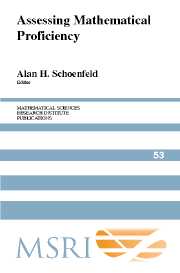Book contents
- Frontmatter
- Contents
- Preface
- Acknowledgments
- Section 1 The Big Picture
- Section 2 Perspectives on Mathematical Proficiency
- Section 3 What Does Assessment Assess? Issues and Examples
- 6 Mathematical Proficiency: What Is Important? How Can It Be Measured?
- 7 Aspects of the Art of Assessment Design
- 8 Mathematical Proficiency for Citizenship
- 9 Learning from Assessment
- 10 When Assessment Guides Instruction: Silicon Valley's Mathematics Assessment Collaborative
- Section 4 The Case of Algebra
- Section 5 What Do Assessments Assess? The Case of Fractions
- Section 6 The Importance of Societal Context
- Epilogue: What Do We Need to Know? Items for a Research Agenda
- About the Authors
- Subject Index
- Author Index
- Task Index
10 - When Assessment Guides Instruction: Silicon Valley's Mathematics Assessment Collaborative
Published online by Cambridge University Press: 06 July 2010
- Frontmatter
- Contents
- Preface
- Acknowledgments
- Section 1 The Big Picture
- Section 2 Perspectives on Mathematical Proficiency
- Section 3 What Does Assessment Assess? Issues and Examples
- 6 Mathematical Proficiency: What Is Important? How Can It Be Measured?
- 7 Aspects of the Art of Assessment Design
- 8 Mathematical Proficiency for Citizenship
- 9 Learning from Assessment
- 10 When Assessment Guides Instruction: Silicon Valley's Mathematics Assessment Collaborative
- Section 4 The Case of Algebra
- Section 5 What Do Assessments Assess? The Case of Fractions
- Section 6 The Importance of Societal Context
- Epilogue: What Do We Need to Know? Items for a Research Agenda
- About the Authors
- Subject Index
- Author Index
- Task Index
Summary
Standardized testing for the purpose of accountability continues to dominate our nation's schools. Since we first reported on the Mathematics Assessment Collaborative [Foster and Noyce 2004], states have responded to the stringent testing requirements of the No Child Left Behind legislation by expanding annual testing in reading and mathematics to all students in grades 3 through 8. Currently states are adding science tests and more tests in high school. Working under cost constraints, most states elect to use multiple-choice tests, while some commentators such as Peterson [2006] detect a “race to the bottom”—a tendency to lower standards and simplify tests as a way of ensuring that more and more students can be deemed proficient. (See also [Fuller et al. 2006].)
How has assessment been used to inform instruction? A number of districts, challenged urban districts in particular, have responded to the need to boost student scores by increasing the frequency of benchmark assessments. Some districts developed assessments aligned with local curricula to help ensure that coverage and learning across schools. Other districts invested in technologybased programs that offer quarterly updates on student progress along a linear scale, based on easily scored (but often skills-oriented) computer multiplechoice assessments. These programs, while they may reassure a school's staff about student progress or alert them to trouble ahead, do little to inform teachers about how students are thinking, what they understand, where they are falling down, and how, specifically, teachers might change their own instructional practices to address students' difficulties.
- Type
- Chapter
- Information
- Assessing Mathematical Proficiency , pp. 137 - 154Publisher: Cambridge University PressPrint publication year: 2007
- 1
- Cited by

